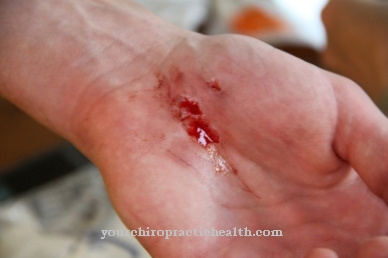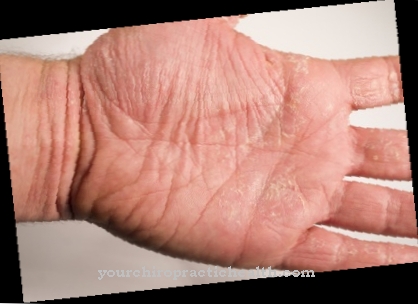Pustules, so painful pus vesicles, can arise from a variety of causes and should therefore not be underestimated in their importance. A visit to the dermatologist can help find the reasons for their occurrence and relieve the patient of the pesky pustules.
What are pustules?

Pustules are blisters filled with pus that can form on the skin for various reasons. They consist of a cavity that is superficial (either in the epidermis or subepidermal) on the skin.
Their content can be infectious or sterile, depending on the cause. Pustules are usually red in color, with the tip of the blister often turning white. In most cases, pustules appear on the skin of the face, neck, shoulders, back, legs and buttocks and are especially painful to the touch.
Usually pustules are not a secondary appearance of another disease, but an independent (primary) change in the skin.
causes
Pustules can develop for a variety of reasons. It is not uncommon for them to occur in connection with advanced acne: In this case, the pustules are formed by a build-up of sebum on the hair follicles, which then become inflamed.
A bacterial infection such as folliculitis can also lead to pustules. Infection with streptococci or staphylococci is possible, especially in children. Although these bacteria are always on the skin, if the immune system is weakened, they can cause highly contagious pustular lichen, which in turn can result in severe kidney damage.
An infection with skin fungi or parasites can also cause pustules. The last common cause of pustules is allergies, in which contact with the allergen can lead to violent, inflammatory skin reactions.
Diseases with this symptom
- allergy
- Candidosis
- acne
- smallpox
- Skin fungus
- Diaper rash
Diagnosis & course
In the case of pustules and other painful changes in the skin, a dermatologist should always be consulted; only this can reliably diagnose whether and what type of pustules it is and how to proceed.
If left untreated, pustules often cause inflammation of the skin, which can spread and damage the skin - including cosmetic damage in particular. However, it is not the pustules themselves that are decisive for the course, but their cause:
While allergens can be avoided and the course remains harmless, an untreated infection can lead to permanent damage. It is therefore urgently advisable to have the pustules treated.
Complications
Pustules usually do not cause major complications. In rare cases, however, the pus can cause an infection of the skin and nerve cells. If left untreated, this can lead to permanent damage such as scars, insensitivity to touch or skin paralysis.
If the pustules are based on an intolerance, depending on the allergy, symptoms such as skin irritation, breathing difficulties, among others, can occur. If the course is severe, the pustules can develop into severe abscesses with pus formation. In rare cases, the pus can penetrate the brain and cause bacterial meningitis.
With larger pustules there is also the risk of phlegmon, i.e. the irritation spreading to the neighboring connective tissue, which is usually associated with fever symptoms and itching. Parasites and fungi as the cause harbor the risk of a weakening of the immune system and can only be treated with rapid therapy without complications.
Typical complications in the treatment of pustules are intolerance to the prescribed medication and a temporary increase in skin irritation until the therapy has been adjusted to the underlying disease. There are usually no serious complications with pustules, provided that treatment is initiated early and there are no underlying diseases or other predispositions.
When should you go to the doctor?
Most of the time, pustules have harmless triggers, such as an irritating skin cream or an itchy item of clothing. However, if the rash persists, there is likely a serious cause that requires a doctor's visit. Medical clarification is particularly recommended for sudden pustules whose cause is unclear. If you experience severe itching and pain, you should speak to your doctor. This is especially true if there are severe accompanying symptoms.
Complaints such as fever, shortness of breath or tremors indicate a serious cause that must be clarified immediately. In the event of skin bleeding and noticeable changes in the skin such as redness or lumps, action should be taken quickly. Likewise, if the pustules spread further or form blisters. Pustules in infants and young children should be clarified immediately by the pediatrician. If you have severe symptoms that require immediate treatment, we recommend going to the emergency room. If pustules develop after an insect bite or contact with irritating substances, the emergency doctor should be called in. Other contact persons are the family doctor or a dermatologist, depending on the suspicion.
Doctors & therapists in your area
Treatment & Therapy
In order to determine the cause of the appearance of the pustules and thus treat them, a dermatologist should be consulted. This will ask the patient about possible causes (such as allergy triggers) and look for further symptoms. They may also have a swab taken from the contents of the pustules, which will be checked for bacteria in the laboratory.
Only then can appropriate treatment measures be taken. So if it is a bacterial infection, the doctor will probably recommend antibiotics to reduce the bacterial density. If the pustules are caused by acne, there are several treatments available, including drugs that reduce the production of sebum. If the pustules are caused by an allergy, either desensitization is carried out or the allergen is avoided.
Parasites and fungi are also treated with appropriate antidotes. In order to support the treatment of the cause, skin care should be optimized in order to regenerate the damaged skin and better protect it from the appearance of new pustules. Which products are used for this depends on the skin type. For severe cases, such as severely inflamed skin, the dermatologist will prescribe or recommend appropriate means to help with the care and treatment of the pustules.
Outlook & forecast
If a form of acne, for example acne vulgaris, is the cause of the pustule formation, the course of the disease is difficult to assess. Without treatment, the condition usually worsens and there is a risk of scarring. The symptoms usually improve after treatment with creams and tinctures that contain an antibacterial agent and also counteract seborrhea. For some patients this is not enough. Oral administration of antibiotics is required here. It may be necessary to change hormonal contraceptives in women.
Acne in adolescents usually goes away on its own once the affected person outgrows puberty. However, acne can also become chronic and cause symptoms for decades, which then usually appear in flares.
Pustules caused by childhood illnesses such as rubella, measles or chickenpox usually heal without a trace. With chickenpox in particular, scratching the pustules can lead to the formation of clearly visible scars on the face. The risk of scarring is particularly high in adults. In children, even scratched blisters usually fade again after several weeks.
Pustules caused by allergies usually heal in a short time once the irritant is identified and avoided.
prevention
In order to prevent the development of new pustules, their triggers should be avoided. This includes known allergy triggers, but also protection against insect bites (for example from ticks). Good, but not excessive, skin hygiene protects against fungal attack. Care products tailored to individual needs, but also saunas and steam baths, also help to strengthen the skin's function and protect it from pustules in the best possible way.
You can do that yourself
Pustules can be treated yourself with various home remedies and measures. Anyone suffering from a rash should first make sure that the symptoms are not caused by an allergy or a serious skin condition. It is often sufficient to use care products tailored to individual needs in order to strengthen the skin's function and prevent pustules.
Sauna and steam baths, but also warm compresses with anti-inflammatory herbs such as chamomile or sage, help against redness and itching. Cold compresses are ideal for treating sudden pustules, while chronic complaints can be relieved with anti-inflammatory peppermint or healing clay, among other things. Olive oil is also said to have a special effect. Mixed with honey and applied directly to the pustules, it noticeably relieves the itching and makes the skin supple and elastic again. Alternatively, a gruel made from olive oil, garlic cloves, and chopped basil can be applied to the rash.
Applications with baking powder and oat flakes, but also tea tree oil, aloe vera or calendula help against weeping pustules. In addition, it is important to strengthen the immune system and protect the pustules from hot water and sun contact so that the rash can heal quickly.


.jpg)




















.jpg)



